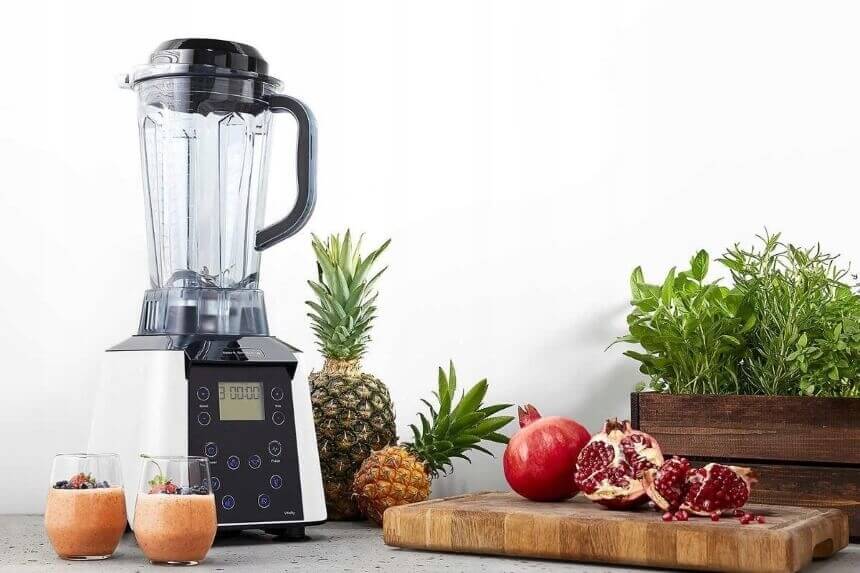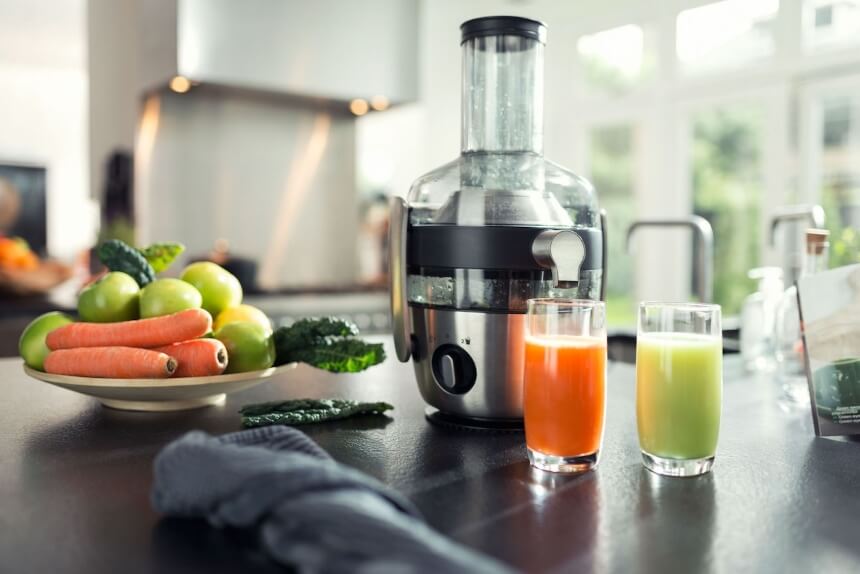Blending and juicing may look like one thing, but they aren’t. They are entirely two different things.
Though the main differences come in the functionalities, you can use both methods to make yummy juices and drinks.
Of course, choosing between a blender and a juicer can be a real headache. And if you don’t know the key differences between the two, it’s evident that you can make the wrong purchase decision.
The truth is, the right machine for you will depend on your preferences.
When you look at most juicers, we often use them for crushing vegetables and fruits to extract the juice from the pulp. They’re available in automatic and manual models.
On the other hand, most blenders come in handy for blending/grinding vegetables, fruits to prepare thick, yummy smoothies. And you’ll find lots of popular blender brands like Nutribullet, Vitamix, and the Ninja.
So, let’s quickly compare and contrast the two machines.

Well, it’s a machine with a rotating blade that crushes vegetables and fruits. There’s an electric motor that powers the blade at the base. It’s powerful enough to crush tough foodstuffs like nuts, ice, and many more.
Blenders more like pulverize your ingredients, which makes them relatively easy to clean. They eliminate fiber during the grinding process.
If you’re a smoothie fanatic, a blender is the right one for you. It results in little to no waste, unlike juicers, where you’ll be remaining with pulps. And depending on the smoothness level you want, you can blend your foodstuff for as long as you want.
However, we recommend getting the right balance between your ingredients and the blending time for a perfectly smooth blend with high nutritional value.
Most people always assume that it’s only the high-end blenders that offer great results. Well, there are other budget-friendly models that will meet your kitchen needs.
And while you shop online, some of the features you can anticipate to find in a good blender include visible measurement marks, great power capabilities, and quick pulse blending, among others.
Remember that blenders are available in multiple types and sizes, and we’ll discuss each one of them later. We also have newer models that can be used with any container.
If a blender fits your needs, it’s worth knowing the main models around.
There are lots of them, and each one offers unique functionality.
The blenders you’ll find online include stick blenders, countertops, and portable models, among others. So, let’s review them.
Stick or immersion blenders work like hand mixers, but they’re quite more powerful than them. They have a slim design, and you’ll operate them with the push of a button after immersing the stick in your ingredients. These blenders are great for blending powdered milk and protein shakes, and pudding.
Also referred to as bullet blenders, single-serve blenders are compacts and uniquely designed for users who want to blend small amounts of foodstuff at a go. Experts add that there are bullet blenders with a large capacity to make double serve drinks.
If you’re a traveler and prefer walking with a blender, you can go for portable blenders. They’re relatively new in our markets and are made of transparent glass tubes and a base containing the motor. We recommend them for people who love blending protein shakes and smoothies.
There’s another type of blenders called countertop blenders like the Ninja professional countertop blender designed for kitchens. It has a capacity of up to 72 oz. that is ideal for making smoothies for your family members or groups of people. The good thing with these blenders is they have lids to prevent food from flying off the jar while working. We love that they’re able to mix different fluids, and that’s why we recommend them for adult parties.
If you love baking, you should get a cake mixer to blend your dough thoroughly. They offer the same functionality as hand mixers but are more powerful than them. You can also use them with several attachments.
There are also commercial blenders for hotels, restaurants, and cafes that produce drinks in large quantities. These blenders are more powerful than most of the models above, and we also love that they have a large capacity. You can use them to grind smooth and hard things alike.
Blenders have lots of pros. First, they’re fast, so you’ll make your drink in a few minutes. You may have to spend more time blending if you’re handling tough ingredients.
Most blenders in the market are versatile, meaning you can use them to crush lots of stuff like ice, fruits, vegetables, and many more. Some blenders offer consistent results through their multiple settings that you’ll tweak to fit your needs.
With a good blender, you’ll make juice that boosts your digestion process. The fibers that arise from blending clean up your digestive system. You can create a regular detoxification schedule with a good blender.
It’s worth noting that blenders come in multiple types. There are models meant for bakers, juice fanatics, and protein shakes, as we discussed above. You’ll also find the portable models you’ll carry when hiking, camping, or in parks.
We also love that most blenders cause energy to be released slowly in your system through fibers. You’ll feel energetic for long after drinking your juice.
Also, what experts love most about blenders is they result in little to no waste, unlike juicers. You won’t have to go through the hassle of tossing out waste materials resulting from blending.
Remember, the different types of blenders we discussed earlier have their own pros and cons, but we will review the common cons of owning a blender in this section.
Some blenders are expensive, especially the models with lots of settings and functionality like combo blenders. You can expect to take time to understand the settings.
We noted that most kitchen blenders consume a lot of counter space, but that’s not a big issue if you’re organized.
The large-sized blenders in the market are also time-consuming to clean, especially if you’re handling sticky foodstuff.
With the loud, noisy models, you’ll be disturbing others, and that’s why we recommend using them when few people are at home. You can expect some complaints from your neighbors too.
We also found that small blenders have a low capacity, so you can’t make drinks in large quantities. That’s why it’s vital to consider the amount you’ll be making before purchasing any blender.
Others like hand mixers can strain the hands.
Experts say that most countertops and commercial blenders are bulky, which makes them a headache to transport. You’ll also have to pay more to get a model that you’ll use over the long-term.

If you’re wondering what a juicer is, well, they’re simple machines used for squeezing juice from fruits, vegetables, fruits through what we call juicing.
With juicers, you’ll extract the juice from the pulp of your ingredients. Juicers result in a lot of waste now that you’ll be left with plenty of pulp after juicing, especially if you prepare juice in large quantities.
They can also come with multiple attachment options for juicing lots of stuff from baby food, nuts, nut milk, and breadsticks, among others.
What we love about juicing is, you won’t consume toxins, unlike with blending. Experts say that juicers’ extraction process is ideal for avoiding the consumption of residues of pesticides on the vegetables as you’ll be squeezing your juice and tossing them away.
Like blenders, there are lots of juicers in the market, from centrifugal to masticating juicers, and they have their good and bad sides, which we will discuss later.
There are several types of juicers like masticating, centrifugal and hydraulic press, among others.
The first type of juicer you’ll come across multiple times online is the centrifugal juicer. It has a rotating blade and mesh filter for extracting juice from your foodstuff. You’ll use a food tube to channel your fruits and vegetables to the shredding blade to make your juice.
We have masticating juicers for slow presses like the Tribest SW-2000 Slowstar. It offers 47 RPM for low oxidation levels so that your juice lasts long upon storage. It manually chews your fruits and vegetables to produce the pulp resulting in a richer juice with vibrant color. You’ll also find masticating juicers offering up to 120 RPM.
The other type of juicer we have is the auger-type. It has a low RPM like the masticating models. And they come in two main types; single and twin auger gears. Single augers are suitable for squeezing juice from leafy greens, grasses, and soft fruits. The double auger does the same but struggles with squeezing fruits.
The other types of juicers we have include manual and citrus juicers. A manual juicer has a hand and crank for applying pressure and squeezing out your juice.
The citrus juicers are mainly used for grapefruits, pomegranates, lemons, limes, and oranges.
Let’s discuss the benefits of juicers.
First, they can grind lots of foodstuff from kale, spinach, and kale, but it’s better to pick a model specializing in grinding given ingredients, say fruits or vegetables.
With a well-functioning juicer, you’ll enjoy toxin-free juice. Unlike blenders, you won’t be grinding your leafy vegetables containing pesticides and other toxins. Instead, you’ll discard them after juicing.
Juices made from these machines are of high nutritional value as you’ll be squeezing the juice directly from your ingredients. You’ll digest them easily, unlike fiber-rich drinks from blenders. Experts add that blending results in fiber-rich drinks that slow down your digestion process.
We have space-saving models for users with limited counter space. Most centrifugal juicers stand horizontally; hence consume less counter space.
If you’re worried about the noise erupting from blenders, you can opt for a twin gear juicer with a silent operation. They can also make lots of foodstuff from sorbets, pasta, to nut butter.
Overall, there are lots of premium and budget-friendly juicers available online. You can get an effective model with as little as $100.
Now that there are lots of juicers, each one of them has its cons.
For instance, most centrifugal juicers have high RPM, which results in high oxidations amounts that reduce your drink’s quality. It won’t stay fresh for long if you store it. They are not good for making juices from wheatgrass and other leafy greens. Experts add that centrifugal juicers are noisy.
Masticating juicers are more expensive than most juicers, which may be due to the advanced features they come with. Though their oxidation levels are relatively low, masticating juicers are slow. We noted that they are also bulky and daunting to clean.
If you go for twin gear juicers, expect to spend more than you’d have with a slow or centrifugal juicer. So far, they’re the hardest to clean and consume a lot of your counter space.
We’ve covered the key things you should know about juicers and blenders, so it’s up to you to decide the one that fits your needs.
Both juicers and blenders work well, but as you’ve seen, the difference comes in their features, functionality, brands, and sizes.
You’ll find both low- and high-end models online. There’s no problem spending more to get a quality model that will serve you over the long-term.
Experts also feel that it’s worth spending on a model specializing in blending or juicing a given ingredient. Juicers designed for juicing fruits work better than general models.
So, consider what you’ll be making most of the time, then factor in your budget and the output, and you’re good to go.